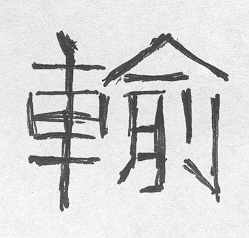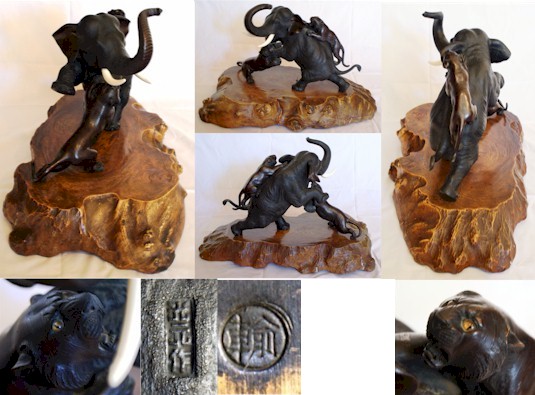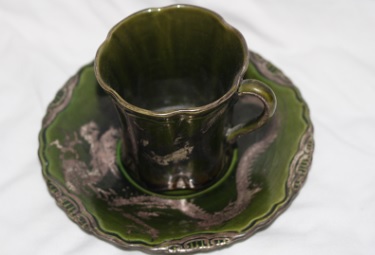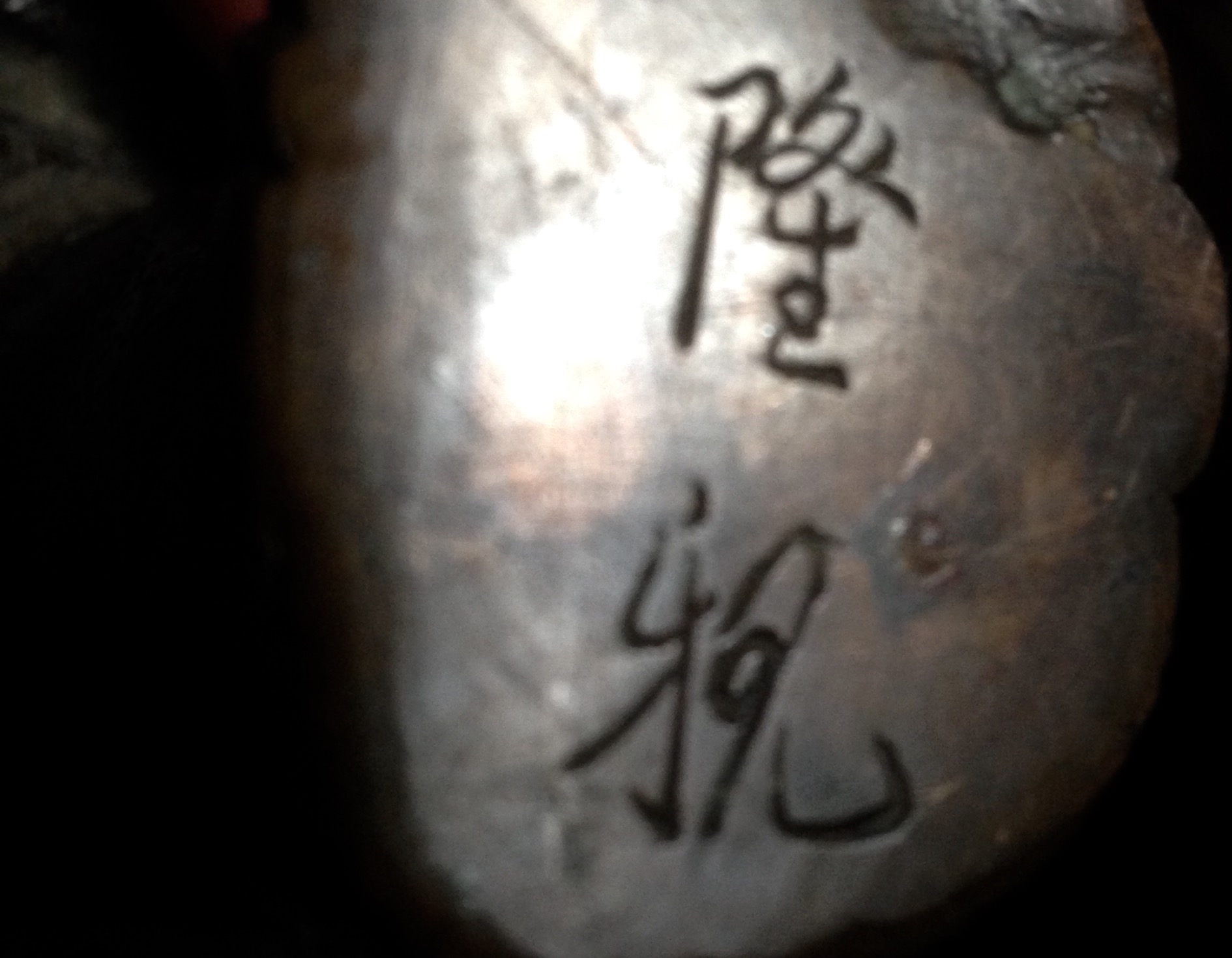
|
Subject:Re: Markings on Meiji period bronze Elephant & Tigers
Posted By: Bill H Tue, Jul 14, 2009
Using an online machine translation program maintained by Jim Breen of the Australian Monash University, I also came up with Mitsumoto for the name in the rectangular cartouche.
I determined that the kanji in the round cartouche could be one or two characters. The element on the left has the root meaning of Cart, which stands alone as the following surnames: Kuruma, Sha, Cha, Kurumazaki and Shiya or Chiya (a given name).
The element on the right is the surname Yu in Chinese. In Japanese it also is used for the surnames Yu and Yutsu, as well as Satoshi, a male given name.
Treating these elements as separate characters and using right-to-left order, I ran the two from the round cartouche through the same translation program and got back the Japanese given name "Oobako."
As a single character, the kanji in the round cartouche can be transcribed as Yu, Shu, Okuru or Itasu, with a root meaning of transport. It seems to be used exclusively in compounds in Japanese.
The character (if that's what it is supposed to be) on the right in the round cartouche consists of the walking "Man" radical on top, a "One" beneath it, then on the bottom, a "Moon" at the left and "knife" at the right. A variant of the character uses a "Knife" that is bent like two arrowheads. The kanji pronunciations vary, depending on which variant is used, but my browser won't let me upload characters to illustrate the matter.
I hope someone else can make sense of all this, because my expertise ends at operating the online machine translator.
Cheers,
Bill H.


|
 Markings on Meiji period bronze Elephant & Tigers
Markings on Meiji period bronze Elephant & Tigers  ( China & Japan ) - Joel Johnstone - Jul 06, 2009 (11:15 PM)
( China & Japan ) - Joel Johnstone - Jul 06, 2009 (11:15 PM)  Re: Markings on Meiji period bronze Elephant & Tigers - Guy - Jul 08, 2009 (09:34 AM)
Re: Markings on Meiji period bronze Elephant & Tigers - Guy - Jul 08, 2009 (09:34 AM)  Re: Markings on Meiji period bronze Elephant & Tigers - Joel Johnstone - Jul 09, 2009 (10:54 AM)
Re: Markings on Meiji period bronze Elephant & Tigers - Joel Johnstone - Jul 09, 2009 (10:54 AM)  Re: Markings on Meiji period bronze Elephant & Tigers - Guy - Jul 10, 2009 (01:08 AM)
Re: Markings on Meiji period bronze Elephant & Tigers - Guy - Jul 10, 2009 (01:08 AM)  Re: Markings on Meiji period bronze Elephant & Tigers
Re: Markings on Meiji period bronze Elephant & Tigers  - Joel Johnstone - Jul 12, 2009 (10:05 PM)
- Joel Johnstone - Jul 12, 2009 (10:05 PM)  Re: Markings on Meiji period bronze Elephant & Tigers - Joel Johnstone - Jul 12, 2009 (10:17 PM)
Re: Markings on Meiji period bronze Elephant & Tigers - Joel Johnstone - Jul 12, 2009 (10:17 PM)  Re: Markings on Meiji period bronze Elephant & Tigers - Bill H - Jul 14, 2009 (02:36 AM)
Re: Markings on Meiji period bronze Elephant & Tigers - Bill H - Jul 14, 2009 (02:36 AM)  Re: Markings on Meiji period bronze Elephant & Tigers - Joel Johnstone - Jul 14, 2009 (11:01 PM)
Re: Markings on Meiji period bronze Elephant & Tigers - Joel Johnstone - Jul 14, 2009 (11:01 PM)  Re: Markings on Meiji period bronze Elephant & Tigers - Guy - Jul 17, 2009 (12:50 PM)
Re: Markings on Meiji period bronze Elephant & Tigers - Guy - Jul 17, 2009 (12:50 PM)  Re: Markings on Meiji period bronze Elephant & Tigers - Jason Carpenter - Sep 30, 2009 (06:56 PM)
Re: Markings on Meiji period bronze Elephant & Tigers - Jason Carpenter - Sep 30, 2009 (06:56 PM)  Re: Markings on Meiji period bronze Elephant & Tigers - Joel Johnstone - Sep 30, 2009 (10:51 PM)
Re: Markings on Meiji period bronze Elephant & Tigers - Joel Johnstone - Sep 30, 2009 (10:51 PM)  Re: Markings on Meiji period bronze Elephant & Tigers - Jason Carpenter - Oct 02, 2009 (05:16 PM)
Re: Markings on Meiji period bronze Elephant & Tigers - Jason Carpenter - Oct 02, 2009 (05:16 PM)  marking on Japanese bronze
marking on Japanese bronze  - Paul - Jun 10, 2014 (01:21 PM)
- Paul - Jun 10, 2014 (01:21 PM)  Re: Markings on Meiji period bronze Elephant & Tigers
Re: Markings on Meiji period bronze Elephant & Tigers  - Tony Tuttle - Dec 09, 2015 (08:23 AM)
- Tony Tuttle - Dec 09, 2015 (08:23 AM)  Re: Markings on Meiji period bronze Elephant & Tigers - Bill H - Dec 10, 2015 (05:13 AM)
Re: Markings on Meiji period bronze Elephant & Tigers - Bill H - Dec 10, 2015 (05:13 AM)  Re: Markings on Meiji period bronze Elephant
Re: Markings on Meiji period bronze Elephant  - Sophia - Jan 24, 2016 (10:45 AM)
- Sophia - Jan 24, 2016 (10:45 AM) 


